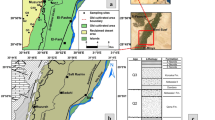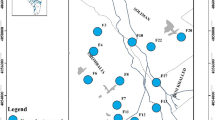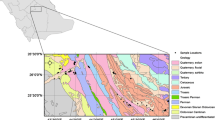Abstract
Thirty groundwater samples were collected from the dug well aquifer of Islamkot sub-district, Southern Sindh, Pakistan, during March, 2021 to investigate their hydrogeochemical characteristics and fitness for drinking and irrigation use. The results of multivariate statistical, hydrogeochemical, and chloro-alkaline indices and two-component variable graphs confirm ion exchange (advanced and reverse) processes in the study area. Gibb’s plots reveal that silicate weathering and evaporation are significant processes that govern water geochemistry. Principal component analysis and correlation coefficient reveal that total dissolved solids, electrical conductivity, Mg+2, Na+, Cl−, and SO4−2 were positively correlated and similarly confirmed through hierarchical cluster analysis. The mineralogical study of the aquifer sediment reveals that quartz, clay, calcite, and dolomite minerals were present, and the saturation index indicated that halite is under-saturated relative to groundwater samples and may lead to the dissolution of halite and increase the concentration of Na+ and Cl−. Chadha diagram indicates that Na+, K+, Cl−, and SO4−2 hydrogeochemical facies and Van Wardhum plot reveal the thalassotrophic water type in the study area. The drinking water quality index reflects that 50% of groundwater was unsuitable for drinking. Wilcox and salinity hazard diagram reveal that most samples clustered in very high salinity and very high sodium water type. Sodium adsorption ratio, Kelly’s ratio, and sodium percentage reveal that most groundwater samples were unfit for agriculture use. However, residual sodium carbonate and the results of the permeability index were suitable for irrigation purposes.














Similar content being viewed by others
References
Adebayo TB, Abegunrin TP, Awe GO, et al (2020) Geospatial mapping and suitability classification of groundwater quality for agriculture and domestic uses in a Precambrian basement complex. Groundw Sustain Dev 100497https://doi.org/10.1016/j.gsd.2020.100497
Amiri V, Bhattacharya P, Nakhaei M (2021) The hydrogeochemical evaluation of groundwater resources and their suitability for agricultural and industrial uses in an arid area of Iran. Groundw Sustain Dev 12:100527. https://doi.org/10.1016/j.gsd.2020.100527
Amiri V, Li P, Bhattacharya P, Nakhaei M (2021) Mercury pollution in the coastal Urmia aquifer in northwestern Iran: potential sources, mobility, and toxicity. Environ Sci Pollut Res 28:17546–17562. https://doi.org/10.1007/s11356-020-11865-y
Amiri V, Nakhaei M, Lak R, Kholghi M (2016) Assessment of seasonal groundwater quality and potential saltwater intrusion: a study case in Urmia coastal aquifer (NW Iran) using the groundwater quality index (GQI) and hydrochemical facies evolution diagram (HFE-D). Stoch Environ Rese Risk Assess 30:1473–1484. https://doi.org/10.1007/s00477-015-1108-3
Amiri V, Rezaei M, Sohrabi N (2014) Groundwater quality assessment using entropy weighted water quality index (EWQI) in Lenjanat Iran. Environ Earth Sci 72:3479–3490. https://doi.org/10.1007/s12665-014-3255-0
Amiri V, Salahaddin K, Arslan A et al (2021) Groundwater quality evaluation using Shannon information theory and human health risk assessment in Yazd province, central plateau of Iran. Environ Sci Pollut Res 28:1108–1130. https://doi.org/10.1007/s11356-020-10362-6
Amiri Vahab, Sohrabi, et al (2015) Evaluation of groundwater chemistry and its suitability for drinking and agricultural uses in the Lenjanat plain, central Iran. Environ Earth Sci 74:6163–6176. https://doi.org/10.1007/s12665-015-4638-6
APHA (2012) Standard methods for examination of water and wastewater. In: American Public Health Association., 22nd ed. Washington, DC
Appelo CAJ, Postma D (2005) Geochemistry, groundwater and pollution. Balkema, Rotterdam, p 656
Barzegar R, AsghariMoghaddam A, Adamowski J, Nazemi AH (2019) Assessing the potential origins and human health risks of trace elements in groundwater: a case study in the Khoy plain Iran. Environ Geochem Health 41:981–1002. https://doi.org/10.1007/s10653-018-0194-9
Bashir E, Huda SN, Naseem S et al (2017) Geochemistry and quality parameters of dug and tube well water of Khipro, District Sanghar, Sindh, Pakistan. Appl Water Sci 7:1645–1655. https://doi.org/10.1007/s13201-015-0316-9
Bhakar P, Singh AP (2019) Groundwater quality assessment in a hyper-arid region of Rajasthan, India. Nat Resour Res 28:505–522. https://doi.org/10.1007/s11053-018-9405-4
Bodrud-Doza M, Bhuiyan MAH, Islam SMDU et al (2019) Hydrogeochemical investigation of groundwater in Dhaka City of Bangladesh using GIS and multivariate statistical techniques. Groundw Sustain Dev 8:226–244. https://doi.org/10.1016/j.gsd.2018.11.008
Bouderbala A, Gharbi BY (2017) Hydrogeochemical characterization and groundwater quality assessment in the intensive agricultural zone of the Upper Cheliff plain, Algeria. Environ Earth Sci 76https://doi.org/10.1007/s12665-017-7067-x
Boufekane A, Saighi O (2019) Assessing groundwater quality for Irrigation using geostatistical method – case of wadi Nil Plain (North-East Algeria). Groundw Sustain Dev 8:179–186. https://doi.org/10.1016/j.gsd.2018.11.003
Brahman KD, Kazi TG, Afridi HI et al (2013) Evaluation of high levels of fluoride, arsenic species and other physicochemical parameters in underground water of two sub districts of Tharparkar, Pakistan: a multivariate study. Water Res 47:1005–1020. https://doi.org/10.1016/j.watres.2012.10.042
Carol ES, Kruse EE, Laurencena PC et al (2012) Ionic exchange in groundwater hydrochemical evolution. Study case: the drainage basin of El Pescado creek (Buenos Aires province, Argentina). Environ Earth Sci 65:421–428. https://doi.org/10.1007/s12665-011-1318-z
Chadha DK (1999) A proposed new diagram for geochemical classification of natural waters and interpretation of chemical data. Hydrogeol J 7:431–439. https://doi.org/10.1007/s100400050216
Chen J, Huang Q, Lin Y et al (2019) Hydrogeochemical characteristics and quality assessment of groundwater in an irrigated region, Northwest China. Water (Switzerland) 11:1–18. https://doi.org/10.3390/w11010096
Chintalapudi P, Pujari P, Khadse G, et al (2017) Groundwater quality assessment in emerging industrial cluster of alluvial aquifer near Jaipur, India. Environ Earth Sci 76. https://doi.org/10.1007/s12665-016-6300-3
Chitsazan M, Aghazadeh N, Mirzaee Y et al (2017) Hydrochemical characteristics and quality assessment of urban groundwater in Urmia City, NW Iran. Water Science and Technology: Water Supply 17:1410–1425. https://doi.org/10.2166/ws.2017.039
de Wall H, Pandit MK, Donhauser I et al (2018) Evolution and tectonic setting of the Malani – Nagarparkar Igneous Suite: a Neoproterozoic silicic-dominated large igneous province in NW India-SE Pakistan. J Asian Earth Sci 160:136–158. https://doi.org/10.1016/j.jseaes.2018.04.016
Egbueri JC (2019) Water quality appraisal of selected farm provinces using integrated hydrogeochemical , multivariate statistical , and microbiological technique. Model Earth Syst Environ 0:0. https://doi.org/10.1007/s40808-019-00585-z
Farooque LM, Khuhawar MY, Jahangir TM, et al (2021) Evaluation of hydrochemistry of the Dokri groundwater, including historical site Mohenjo-Daro, Sindh, Pakistan. Int J Environ Anal Chem 0:1–25https://doi.org/10.1080/03067319.2021.1884241
Fassett and Durrani (1994) Geology and coal resources of the Thar Coal Field, Sindh Province, Pakistan. 87
Gibbs RJ (1970) Mechanisms controlling world water chemistry. Science 170:1088–1090
GidayAdhanom O (2019) Salinity and sodicity hazard characterization in major irrigated areas and irrigation water sources, Northern Ethiopia. Cogent Food Agric 5:1–15. https://doi.org/10.1080/23311932.2019.1673110
Hakro AAAD, Xiao W, Yan Z, Mastoi AS (2018) Provenance and tectonic setting of Early Eocene Sohnari Member of Laki Formation from southern Indus Basin of Pakistan. Geolo J 1–17. https://doi.org/10.1002/gj.3011
Imran M, Jahanzaib S, Ashraf A (2017) Using geographical information systems to assess groundwater contamination from arsenic and related diseases based on survey data in Lahore, Pakistan. Arab J Geosci 10. https://doi.org/10.1007/s12517-017-3212-9
Karakuş CB, Yıldız S (2020) Evaluation for irrigation water purposes of groundwater quality in the vicinity of Sivas City Centre (Turkey) by using Gis and an irrigation water quality index. Irrigation and Drainage 69:121–137. https://doi.org/10.1002/ird.2386
Kazi TG, Arain MB, Jamali MK et al (2009) Assessment of water quality of polluted lake using multivariate statistical techniques: a case study. Ecotoxicol Environ Saf 72:301–309. https://doi.org/10.1016/j.ecoenv.2008.02.024
Khanoranga Khalid S (2019) An assessment of groundwater quality for Irrigation and drinking purposes around brick kilns in three districts of Balochistan province, Pakistan, through water quality index and multivariate statistical approaches. J Geochem Exploration 197:14–26. https://doi.org/10.1016/j.gexplo.2018.11.007
Khuhawar MY, Ursani H-R, Taj, et al (2019) Hydrologic engineering assessment of water quality of groundwater of Thar Desert . J Hydrogeol Hydrol Eng Res 0–14. https://doi.org/10.4172/2325-9647.1000171
Kumar S, Rajesh V, Khan N (2020a) Evaluation of groundwater quality in Ramanathapuram district, using water quality index (WQI). Model Earth Syst Environ. https://doi.org/10.1007/s40808-020-01025-z
Kumar SK, Rammohan V, Sahayam JD, Jeevanandam M (2009) Assessment of groundwater quality and hydrogeochemistry of Manimuktha River basin, Tamil Nadu, India. Environ Monit Assess 159:341–351. https://doi.org/10.1007/s10661-008-0633-7
Kumar MAA, Memon SA et al (2020b) Impact assessment of groundwater quality using WQI and geospatial tools: a case study of Islamkot, Tharparkar, Pakistan. Engineering Technology & Applied Science Research 10:5288–5294
Lanjwani MF, Khuhawar MY, Jahangir Khuhawar TM et al (2021) Spatial variability and hydrogeochemical characterisation of groundwaters in Larkana of Sindh Pakistan. Groundw Sustain Dev 14:100632. https://doi.org/10.1016/j.gsd.2021.100632
Lanjwani MF, Khuhawar MY, Jahangir Khuhawar TM (2020) Assessment of groundwater quality for drinking and Irrigation uses in taluka Ratodero, district Larkana, Sindh, Pakistan. Int J Environ Anal Chem 0:1–24. https://doi.org/10.1080/03067319.2020.1780222
Li C, Gao Z, Chen H et al (2021) Hydrochemical analysis and quality assessment of groundwater in south-east North China Plain using hydrochemical, entropy-weight water quality index, and GIS techniques. Environ Earth Sci 80:1–15. https://doi.org/10.1007/s12665-021-09823-z
Liu F, Wang S, Yeh TCJ et al (2020) Using multivariate statistical techniques and geochemical modelling to identify factors controlling the evolution of groundwater chemistry in a typical transitional area between Taihang Mountains and North China Plain. Hydrol Process 34:1888–1905. https://doi.org/10.1002/hyp.13701
Luo W, Gao X, Zhang X (2018) Geochemical processes controlling the groundwater chemistry and fluoride contamination in the Yuncheng basin, China—an area with complex hydrogeochemical conditions. PLoS ONE 13:1–25. https://doi.org/10.1371/journal.pone.0199082
Mastoi AS, Yang X, Deng J, Hakro AAAD (2019) Early neoproterozoic evolution of Southeast Pakistan: evidence from geochemistry, geochronology, and isotopic composition of the Nagarparkar Igneous Complex. Int Geol Rev 61:1391–1408. https://doi.org/10.1080/00206814.2018.1512905
Mgbenu CN, Egbueri JC (2019) The hydrogeochemical signatures , quality indices and health risk assessment of water resources in Umunya district , south-east Nigeria. Appl Water Sci 1–19. https://doi.org/10.1007/s13201-019-0900-5
Mirabbasi R, Mazloumzadeh SM, Rahnama MB (2008) Evaluation of irrigation water quality using fuzzy logic. Res J Environ Sci 2:340–352
Mukherjee A, Fryar AE (2008) Deeper groundwater chemistry and geochemical modeling of the arsenic affected western Bengal basin, West Bengal, India. Appl Geochem 23:863–894. https://doi.org/10.1016/j.apgeochem.2007.07.011
Mumtaz A (2017) Assessment of drinking water quality status and its impact on health in Tandojam City. J Basic Appl Sci 13:363–369. https://doi.org/10.6000/1927-5129.2017.13.60
Nakhaei M, Dadgar MA, Amiri V (2016) Geochemical processes analysis and evaluation of groundwater quality in Hamadan Province, Western Iran. Arab J Geosci 9:1–13. https://doi.org/10.1007/s12517-016-2409-7
Qishlaqi A, Kordian S, Parsaie A (2017) Hydrochemical evaluation of river water quality—a case study. Appl Water Sci 7:2337–2342. https://doi.org/10.1007/s13201-016-0409-0
Rafique T, Naseem S, Usmani TH et al (2009) Geochemical factors controlling the occurrence of high fluoride groundwater in the Nagar Parkar area, Sindh, Pakistan. J Hazard Mater 171:424–430. https://doi.org/10.1016/j.jhazmat.2009.06.018
Raj D, Shaji E (2017) Fluoride contamination in groundwater resources of Alleppey, southern India. Geosci Front 8:117–124
Ramesh K, Jagadeeswari BP (2012) Hydrochemical characteristics of groundwater for domestic and irrigation purposes in Periyakulam taluk of Theni district, Tamil Nadu. Int Res J Environ Sci 1:19–27
Rana V, Maiti SK (2018) Municipal wastewater treatment potential and metal accumulation strategies of Colocasia esculenta (L.) Schott and Typha latifolia L. in a constructed wetland. Environ Monit Assess 190:. https://doi.org/10.1007/s10661-018-6705-4
Saleh A, Al-Ruwaih F, Shehata M (1999) Hydrogeochemical processes operating within the main aquifers of Kuwait. J Arid Environ 42:195–209. https://doi.org/10.1006/jare.1999.0511
Sami K (1992) Recharge mechanisms and geochemical processes in a semi-arid sedimentary basin, Eastern Cape, South Africa. J Hydrol 139:27–48. https://doi.org/10.1016/0022-1694(92)90193-Y
Samtio MS, Rajper KH, Mastoi AS, et al (2021) Hydrochemical assessment of groundwater from taluka Dahili, Thar Desert, Pakistan, for irrigation purpose using water quality indices. Int J Environ Anal Chem 0:1–17. https://doi.org/10.1080/03067319.2021.1893705
Schoeller H (1965) Qualitative evaluation of groundwater resources. Methods and techniques of groundwater investigations and development UNESCO 5483
Selvakumar S, Ramkumar K, Chandrasekar N et al (2017) Groundwater quality and its suitability for drinking and irrigational use in the Southern Tiruchirappalli district, Tamil Nadu, India. Appl Water Sci 7:411–420. https://doi.org/10.1007/s13201-014-0256-9
Siddha S, Sahu P (2020) Assessment of groundwater quality and associated human health risk of Central Gujarat, India. CLEAN – Soil, Air, Water 2000056:2000056. https://doi.org/10.1002/clen.202000056
Singh AP, Bhakar P (2021) Development of groundwater sustainability index: a case study of western arid region of Rajasthan, India. Environ Dev Sustain 23:1844–1868. https://doi.org/10.1007/s10668-020-00654-9
Singh AP, Khakolia A, Tavanshetti S, Yadav J (2019) Groundwater quality assessment using gis and fuzzy logic-a case study of jhunjhunu district. Pollut Res 38:655–662
Singh CK, Kumar A, Shashtri S et al (2017) Multivariate statistical analysis and geochemical modeling for geochemical assessment of groundwater of Delhi, India. J Geochem Exploration 175:59–71. https://doi.org/10.1016/j.gexplo.2017.01.001
Sohail MT, Delin H, Talib MA et al (2014) An analysis of environmental law in Pakistan-policy and conditions of implementation. Res J Appl Sci Eng Technol 8:644–653
Soomro F, Rafique T, Michalski G, et al (2017) Occurrence and delineation of high nitrate contamination in the groundwater of Mithi sub-district, Thar Desert, Pakistan. Environ Earth Sc 76. https://doi.org/10.1007/s12665-017-6663-0
Suk and Lee (2005) Characterization of a ground water hydrochemical system through multivariate analysis: clustering into ground water zones. Groundwater 37:358–366. https://doi.org/10.1111/j.1745-6584.1999.tb01112.x
Suthar J Das, Rajper I, Hassan Z-, et al (2019) Groundwater quality in Islamkot and Mithi Talukas of district Tharparkar, Sindh, Pakistan. Mehran University Research J EngTechnol38:143–150. https://doi.org/10.22581/muet1982.1901.12
Talib MA, Tang Z, Shahab A, et al (2019) Hydrogeochemical characterization and suitability assessment of groundwater: a case study in central Sindh, Pakistan. Int J Environ Res Public Health 16. https://doi.org/10.3390/ijerph16050886
Umar M, Waseem A, Sabir MA et al (2013) The impact of geology of recharge areas on groundwater quality: a case study of Zhob River Basin, Pakistan. Clean - Soil, Air, Water 41:119–127. https://doi.org/10.1002/clen.201100581
Vasanthavigar M, Srinivasamoorthy K, Prasanna MV (2013) Identification of groundwater contamination zones and its sources by using multivariate statistical approach in Thirumanimuthar sub-basin, Tamil Nadu, India. Environ Earth Sci 68:1783–1795. https://doi.org/10.1007/s12665-012-1868-8
Vasanthavigar M, Srinivasamoorthy K, Vijayaragavan K et al (2010) Application of water quality index for groundwater quality assessment: Thirumanimuttar sub-basin, Tamilnadu, India. Environ MonitAssess 171:595–609. https://doi.org/10.1007/s10661-009-1302-1
WHO (2011) World Health Organisation Guidelines for Drinking Water Quality. 1:307–312. https://doi.org/10.1248/jhs1956.35.307
Wirdum V (1980) Description of water-quality changes in a hydrological cycle, for the purpose of nature conservation (in Dutch). In Waterquality in groundwater-flow systems, J.C. Hooghart (ed.), Commission for Hydrological Research TNO
Wu J, Wang L, Wang S et al (2017) Spatiotemporal variation of groundwater quality in an arid area experiencing long-term paper wastewater irrigation, northwest China. Environ Earth Sci 76:1–14. https://doi.org/10.1007/s12665-017-6787-2
Zaigham NA (2003) Strategic Sustainable Development of Groundwater in Thar Desert of Pakistan. water resources in the south: present scenario and future prospects, 56 61–74
Zaigham NA, Ahmad M, Hisam N (2012) Thar Rift and its significance for hydrocarbons *. 20146
Zakaria N, Anornu G, Adomako D et al (2021) Evolution of groundwater hydrogeochemistry and assessment of groundwater quality in the Anayari catchment. Groundw Sustain Dev 12:100489. https://doi.org/10.1016/j.gsd.2020.100489
Zakaria N, Anornu G, Adomako D, et al (2020) Evolution of groundwater hydrogeochemistry and assessment of groundwater quality in the Anayari catchment. Groundw Sustain Dev 100489. https://doi.org/10.1016/j.gsd.2020.100489
Author information
Authors and Affiliations
Corresponding author
Ethics declarations
Conflict of interests
The authors declare no competing interests.
Additional information
Responsible Editor: Broder J. Merkel
Supplementary Information
Below is the link to the electronic supplementary material.
Rights and permissions
About this article
Cite this article
Samtio, M.S., Rajper, K.H., Hakro, A.A.a.D. et al. Impact of water–sediment interaction on hydrogeochemical signature of dug well aquifer by using geospatial and multivariate statistical techniques of Islamkot sub-district, Tharparkar district, Sindh, Pakistan. Arab J Geosci 15, 167 (2022). https://doi.org/10.1007/s12517-022-09436-1
Received:
Accepted:
Published:
DOI: https://doi.org/10.1007/s12517-022-09436-1




